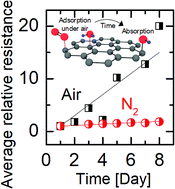Influence of atmospheric species on the electrical properties of functionalized graphene sheets
Abstract
We report on the time-dependent influence of atmospheric species on the electrical properties of functionalized graphene sheets (FGSs). When exposed to laboratory air, FGSs exhibit a significant, irreversible decrease in electrical conductance with time, strongly depending on the oxygen content of the FGSs. To separate the roles of charge carrier density and mobility in this aging process, we performed electron transport measurements using a back-gate field-effect transistor architecture. Investigating the position of the Dirac point under different atmospheres, we found that adsorbed atmospheric species result in pronounced p-doping, which – on a short time scale – can be reversed under nitrogen atmosphere. However, on a time scale of several days, the resistance increases irreversibly, while the Dirac point voltage remains constant. From these experiments, we conclude that the aging of FGSs is related to the chemisorption of atmospheric species leading to enhanced carrier scattering due to an increasing amount of sp3- regions and thus to a reduced charge carrier mobility.

- This article is part of the themed collection: Editors’ collection: Graphene


 Please wait while we load your content...
Please wait while we load your content...